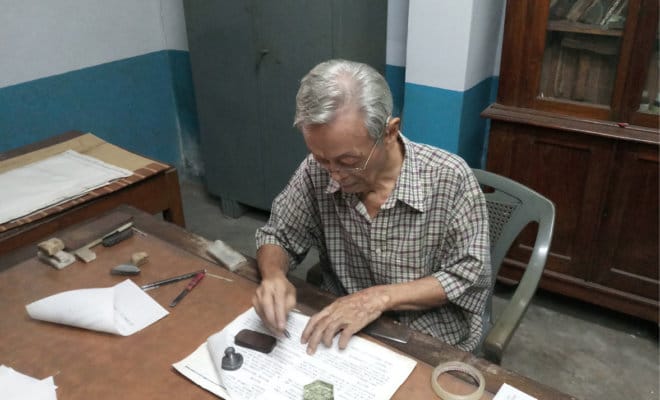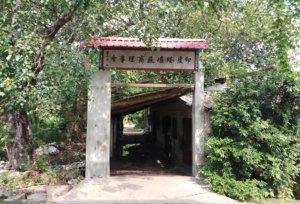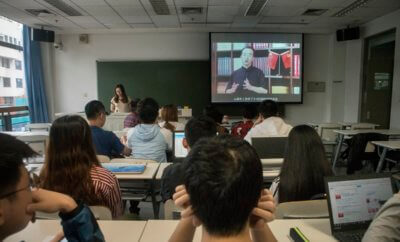Books
The Last Chinese Newspaper In India

K.T. Chang, editor and publisher of the Overseas Chinese Commerce of India, the only surviving Chinese newspaper in India.
The newspaper, in publication for nearly five decades, was established by Lee Youn Chin, a community leader and an eminent tanner in March 1969.
A newspaper office is usually chaotic with phones ringing continuously, correspondents bustling with news stories, sub-editors polishing articles, editors debating story angles and placements.
But the noise and cacophony is eerily missing in the placid offices of the Overseas Chinese Commerce of India, the only Chinese newspaper published in the country, from Kolkata, the capital of West Bengal.
Situated in Tangra Lane, popularly known as Chinatown because of the dominance of the Chinese community in the area, there is nothing to suggest from outside that the dilapidated building houses the office of the sole Chinese newspaper in India. The gate is stark, except for a white signage with a scrawl in Mandarin atop the entrance.
On entering the gateway, a plaque identifies the location as the office of Chinese Tannery Owners Association.

The unassuming offices of Overseas Chinese Commerce of India.
A few steps and a left turn lead to a hall where old copies of the newspaper are lying bundled up and piled atop each other. A layer of thick dust covers some of them, likely because have rested here for a few months.
An elderly bespectacled man, who seems to be in his late 70s and wearing a hearing aid, is sitting on a wooden chair in the next room riveted on some papers that he is carefully studying.
The attendant of the building quietly offers his name: K.T. Chang, editor and publisher of the Overseas Chinese Commerce of India. After an introduction, he offers a seat. He is polite, but reticent.
He is busy.
The newspaper office opens only for four hours every day from 7:30 am to 11:30 am and Chang, along with another “journalist,” have the responsibility to select the news, proof-read and design the 4-page tabloid.
The first page of the black and white tabloid carries international news; page two has a mix of China-specific and city news on the Chinese diaspora, page three has pieces on health care and stories for kids while page four comprises news from Hong Kong, Macau and Taiwan. The newspaper runs a special edition during the Chinese New Year.
Chang agrees to speak briefly between his hectic schedule: “We do not have any correspondents as the local news is not covered by us. We only focus on the news from China and even a news item on India has to be related to China in some way. The articles are being downloaded and printed from Chinese websites. After that, the page is designed for printing.”
The newspaper, in publication for nearly five decades, was established by Lee Youn Chin, a community leader and an eminent tanner in March 1969.
The newspaper has shriveled over the decades as the Chinese population in the city dwindled and Chinese youth turned to other media.
“We publish 200 newspapers daily, but only 180 are sold at a price of Rs 2.50 each. The subscription has dropped drastically over the years because of the young generation switching to English newspapers,” says Chang.
He adds with pride though that people in the community still prefer the newspaper for matrimonial ads, obituaries and to announce social events in the neighborhood.
“We charge from them as we also need revenue to run the daily. They don’t have to pay in advance for advertisements as our newspaper is circulated only in the locality. They just book advertisements over phones and the money is collected later from their homes.”
Although the circulation is restricted to Tangra’s Chinatown and is delivered personally to subscribers, some copies are mailed to customers in Mumbai and Chennai.
Liu Chen, a young Chinese professional, who works in a private multinational in Kolkata, says the newspaper offers little of appeal to him: “The news is often trivial and lacks the latest happenings around the world. In an age of social media and glossy newspapers, it is very difficult to remain stuck with this newspaper, but it’s still a commendable effort to keep our culture alive.”
As the clock strikes 11.30 am, Chang closes the door of his office and unlocks his bicycle to head home. He has completed his job and sent the next day’s newspaper for printing.
As he mounts his bicycle, a slice of Chinese history in India prepares to peddle away with him.



